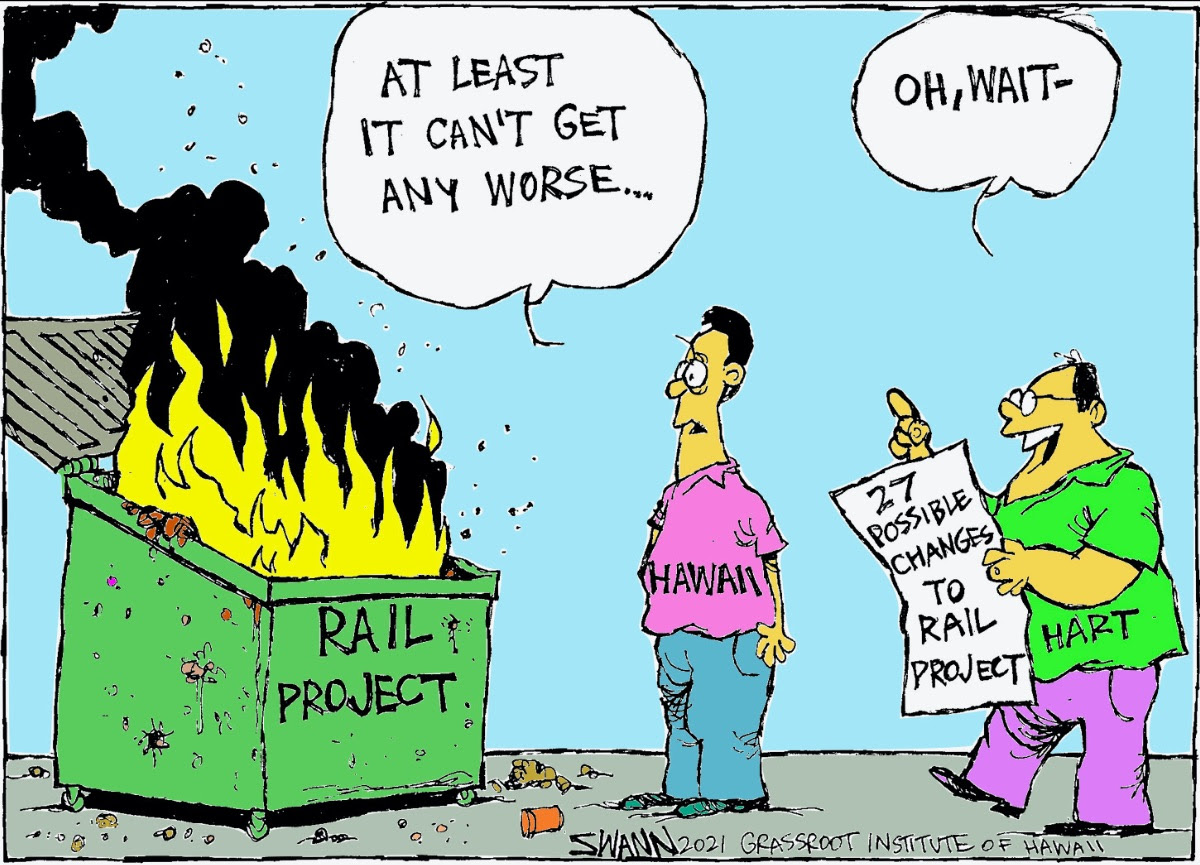
HART officials looking at 27 possible rail changes
Funding worries have forced the Honolulu transit agency to consider alternatives to its original plan, newly released documents show
News Release from Grassroot Institute, April 30, 2021
HONOLULU, April 30, 2021 >> The Honolulu Authority for Rapid Transportation is considering 27 alternatives to its original plan for the troubled Honolulu rail project, according to a document obtained by the Grassroot Institute of Hawaii via an open records request.
The city’s rail agency is faced with a severe funding shortage and is already massively over budget and years behind schedule. Behind closed doors, it has been analyzing both route and technological options that could help it complete the project faster and at less cost.
Currently the project is a steel-on-steel rail system intended to run from Kapolei to Ala Moana Center. Its construction has reached from Kapolei to the Middle Street area, and many people are urging it to stop there.
The HART document, “CITY CENTER GUIDEWAY AND STATIONS: Preliminary Draft Qualitative Evaluation of Potential Project Changes,” shows a table of contents with eight categories of alternatives, with the eighth category, “Move Terminus and Reduce System,” missing from the document.
Alternatives analyzed in the document include:
>> Terminating the rail at Middle Street and switching to bus transit.
>> Terminating at the rail at Middle Street and switching to a lighter rail system to Ala Moana Center.
>> Creating a separate at-grade rail system from Kalihi to Ala Moana with a different technology.
>> Switching from traction power to Maglev technology.
>> Shifting the route’s alignment to Nimitz Highway.
>> Moving multiple rail stations to different locations to save on costs.
>> Tunneling the rail under Dillingham Boulevard to avoid utility conflicts.
>> Tunneling the rail under Dillingham Boulevard and Beretania and South King streets to end at University of Hawaii at Manoa.
The document, marked “CONFIDENTIAL (NOT FOR DISTRIBUTION),” says that stopping the rail at Middle Street could lower costs, provide long-term flexibility for route changes and fleet expansion, and benefit from future driverless technologies.
However, it adds that doing so might require renegotiating with the Federal Transit Administration, which potentially could result in a loss of federal funding. It also could cause slower commutes, impede other modes of traffic, increase the risk of collisions and reduce overall rail ridership, according to the document.
The document also shows that the current route to Ala Moana Center has the most “pros,” such as honoring the agreement made with the FTA, and the fewest “cons,” though none of those include the high cost of the current route.
Joe Kent, institute executive vice president, said the HART document was difficult to obtain, as demonstrated by an exchange between HART board members Natalie Iwasa and Joe Uno and HART Chair Tobias Martyn. At a HART board meeting on March 18, Iwasa asked why the document was confidential.
“I would like to have that clarified why that is considered confidential, and then at what point do you think that will be released to the public,” Iwasa said.
Martyn responded: “We as an organization need to have the confidence of our stakeholders that we are committed to completing the project. … To your specific question, Natalie, we’re not ready to get into having that discussion yet.”
Uno followed up; “I still didn’t hear any reasons specifically why that needed to be confidential.”
The document was made public today only after the Grassroot Institute of Hawaii filed a state Uniform Information Practices Act request.
Keli’i Akina, institute president and CEO, said, “We commend HART for finally putting this document in the public sphere, though it’s not clear why it needed to be kept secret in the first place. The public is paying for this project and should be allowed to see any documents that talk about alternatives that could save money.”
VIEW THE DOCUMENTS